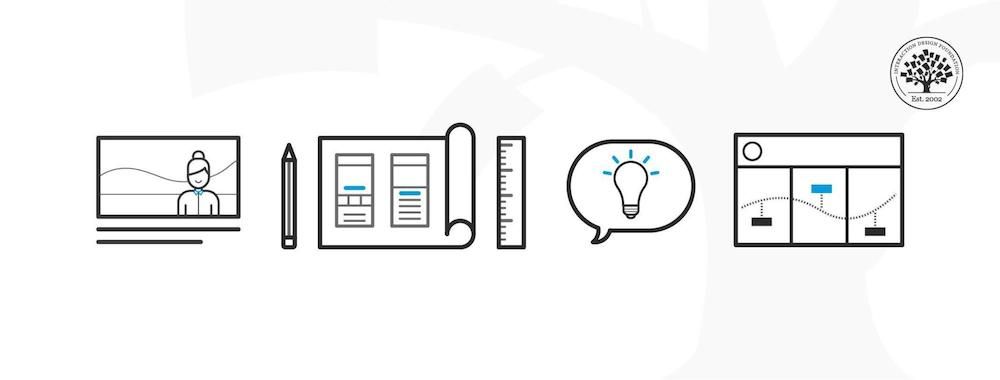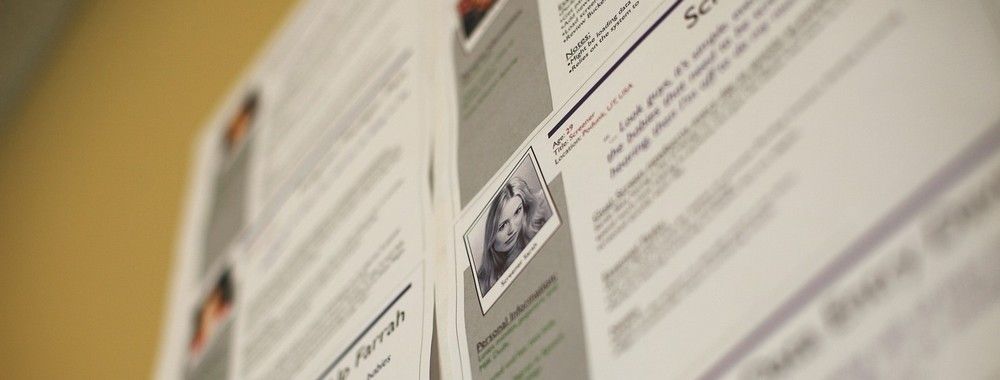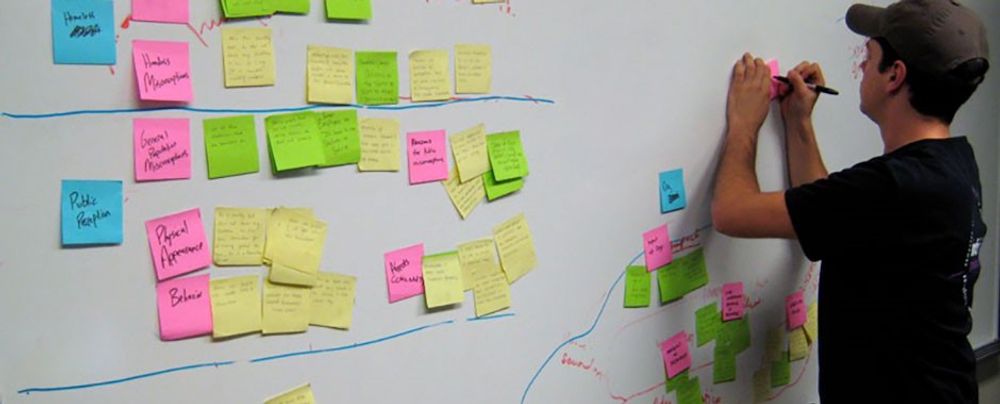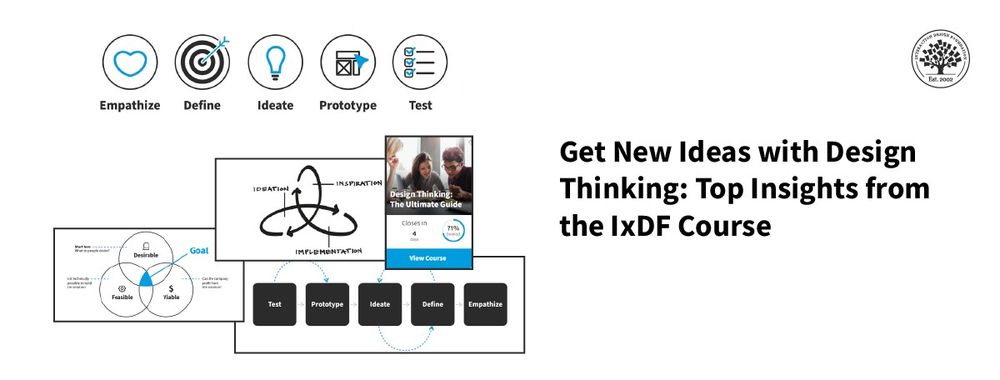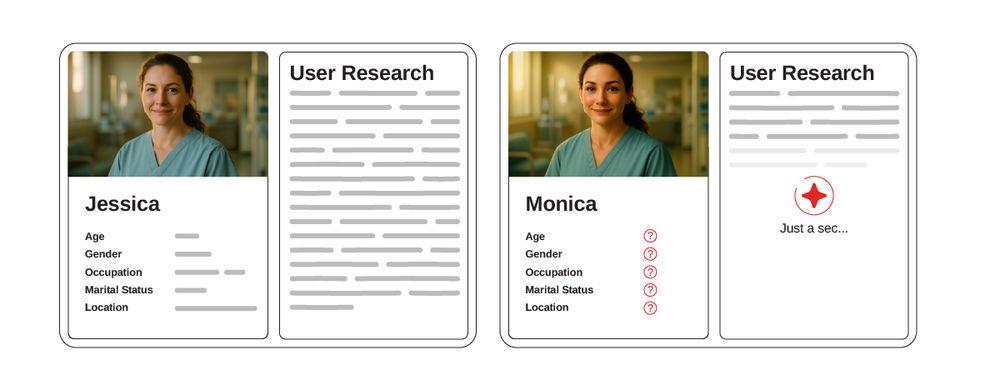When you think of personas, your mind might jump to UX design or marketing. But the truth is, personas are far more versatile than most people realize. Whether you work on mobile apps, train staff, manage patients, or in human resources, personas help you make better, more human-centered decisions. Why? Because they’re rooted in powerful psychological principles that apply to everyone.
Personas work because they mirror how our brains understand, remember, and relate to people. They tap into empathy, reduce mental clutter, and help us see the world through someone else’s eyes.
Let’s dive into the psychology behind personas—and explore why they work in every field, for every job.
1. From Assumptions to Clarity: Personas Foster Focus—A Universal Need
At the core of any successful project is clarity. Clarity about who you're serving, what they need, and why it matters. Personas provide that clarity. They focus your attention on a specific user with defined needs, behaviors, and motivations.
In this video, William Hudson, User Experience Strategist and Founder of Syntagm Ltd, explains how personas help you focus on real people.
Show
Hide
video transcript
- Transcript loading…
Without personas, teams often tailor to the “perfect user”—a mythical creature who is tech-savvy, always available, and never makes mistakes. This results in bloated products or services that try to please everyone and end up delighting no one. Personas steer you away from that trap and give you a concrete point of reference.
Focus isn’t a UX design-only problem. It’s everyone's problem. In healthcare, education, enterprise software, or wherever decisions are being made about people, clarity is essential. By giving your brain a simple, story-based reference point, personas reduce mental overload. You don’t have to juggle dozens of assumptions—just focus on one relatable person. That’s cognitive efficiency in action.
2. The Empathy Factor: Why Personas Feel More Real Than “Users”
Psychologically, we connect more deeply with individuals than we do with groups. This is known as the person-positivity bias. Research shows we’re more empathetic, more engaged, and more likely to act when we’re focused on one person rather than a crowd.
Personas take advantage of this effect. They humanize abstract “users” by giving them a name, a face, and a story. You’re not designing for “customers aged 30–45”—you’re designing for Emily, a busy working mom who needs quick access to reliable health information. That’s a powerful mental shift. This taps into what psychologists call “Theory of Mind”—our ability to imagine someone else’s internal experience. That’s why personas with names and faces trigger real empathy, not abstract sympathy.
And in many organizations, especially those heavy on engineering or technical expertise, empathy can be in short supply. Studies show that individuals in tech-heavy roles often have reduced cognitive empathy—the ability to understand someone else’s perspective. Personas counter this and make user needs more visible and relatable.
In this video, William Hudson explains why you should think of specific people instead of “users.”
Show
Hide
video transcript
- Transcript loading…
3. Avoid Bias and Wasted Efforts in Every Industry
In any field, bias can derail good decision-making. Teams may assume users behave the way they do—or worse, they build solutions based on second-hand opinions rather than real evidence. Personas cut through cognitive biases like false consensus (“everyone thinks like me”) by grounding assumptions in real, observed behavior—not guesses.
Personas start with real observations of people in context. Not what they say they do, but what they actually do. This kind of data removes guesswork and creates a foundation for better, more successful design.
And with techniques like triangulation (using multiple research methods), personas become even more robust, helping you see your users from all angles.
4. Personas Make Collaboration Easier Across Departments
Think about your organization: developers, marketers, customer support, project managers, etc. They all have different perspectives—and sometimes, wildly different ideas of who the user is.
Personas act as a shared language. They align teams around a single, research-backed understanding of the people they’re serving. This alignment reduces internal conflict, speeds up decision-making, and keeps everyone focused on what really matters.
Psychologists call this a “shared mental model”—when teams have a unified understanding of the user, decision-making becomes easier, faster, and more aligned.
5. Use Personas to Advance Your Career
Personas aren’t just tools for understanding users—you can use personas to better understand the people you work with. When you apply the same mindset to your stakeholders, teammates—or even your manager—you can communicate in ways that are more impactful and persuasive.
Think about it. A product manager focused on timelines and KPIs won’t respond to the same pitch as an executive who cares most about customer satisfaction or revenue impact. If you create informal “stakeholder personas” that capture their goals, frustrations, and communication styles, you can adapt your messaging accordingly. You might highlight metrics for Maria, the product manager, and share customer stories with Joana, the executive. Even internally, personas help you build mental frameworks—schemas—about your teammates’ goals and pain points. It’s strategic empathy in action.
This kind of strategic communication builds trust. It shows empathy and makes it easy for your teammates and stakeholders to work with you. And over time, it positions you as someone who doesn’t just share ideas, you get buy-in for them and align everyone around a shared vision.
As Lead Product Designer at T. Rowe Price Rafael Hernandez explains in his IxDF Master Class on enterprise storytelling, you can get stakeholder buy-in not by pitching features, but by crafting emotional, empathic narratives. He uses a technique called the “golden thread,” which reframes user journeys as emotionally resonant stories—ones that stakeholders can connect with and rally behind. This principle works just as well internally: your stakeholder personas can be the golden threads that align your team’s decision-making around what truly matters.
Show
Hide
video transcript
- Transcript loading…
In other words, thinking in terms of personas doesn’t just make your work better, it makes you better. And that’s often what helps you get noticed, promoted, or invited into the room where big decisions are made.
6. Universally Applicable: Personas Transcend Roles and Sectors
While personas originated in UX design, they’ve proven valuable across industries.
Personas are adaptable. They work anywhere you need to understand people better and design systems, services, experiences, or messages that meet them where they are. Here's some inspirational examples:
Healthcare: Monica, the Silent Sufferer
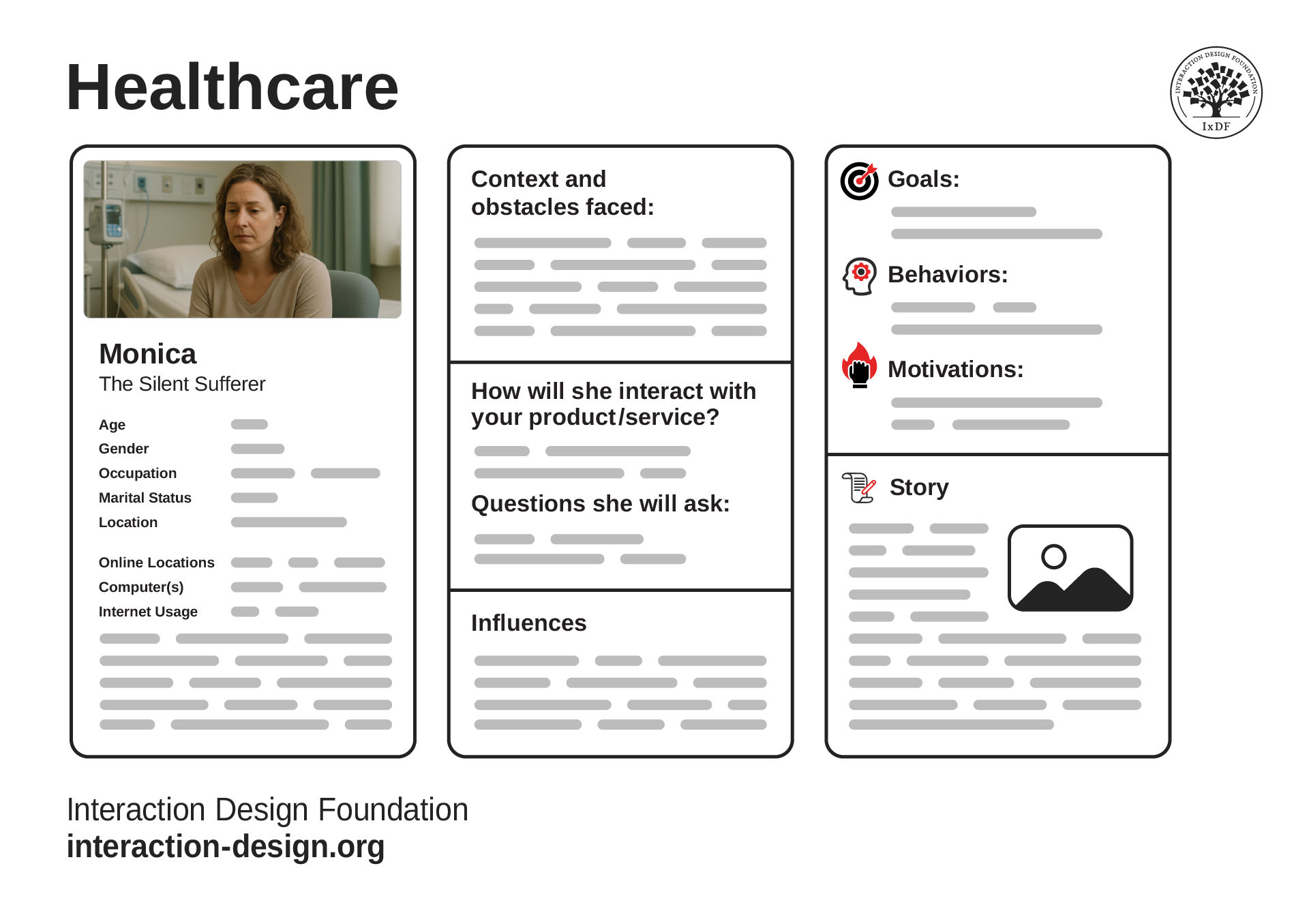
© Interaction Design Foundation, CC BY-SA 4.0
Imagine you're designing a patient portal—but you’ve never lived with chronic pain, confusion, or fear. How do you know what really matters?
Without Personas:
You design for “the average patient.” Interfaces are cluttered with medical jargon, appointment scheduling is clunky, and no one considers that brain fog might make even basic navigation impossible. Monica—like millions with invisible illnesses—feels ignored, lost, and frustrated.
With Personas:
Monica’s persona brings her daily struggle into focus. Her need for simplicity, trust, and emotional support becomes the design’s guiding light. The portal becomes not just functional, but humane.
The Payoff: Design That Heals and Humanizes
When you design with personas like Monica in mind, you go beyond usability—you create healthcare experiences that earn trust, reduce anxiety, and improve real lives. You become the person who bridges the empathy gap in medicine and brings dignity and clarity to those who need it most.
Education: Elijah, the Quiet Star
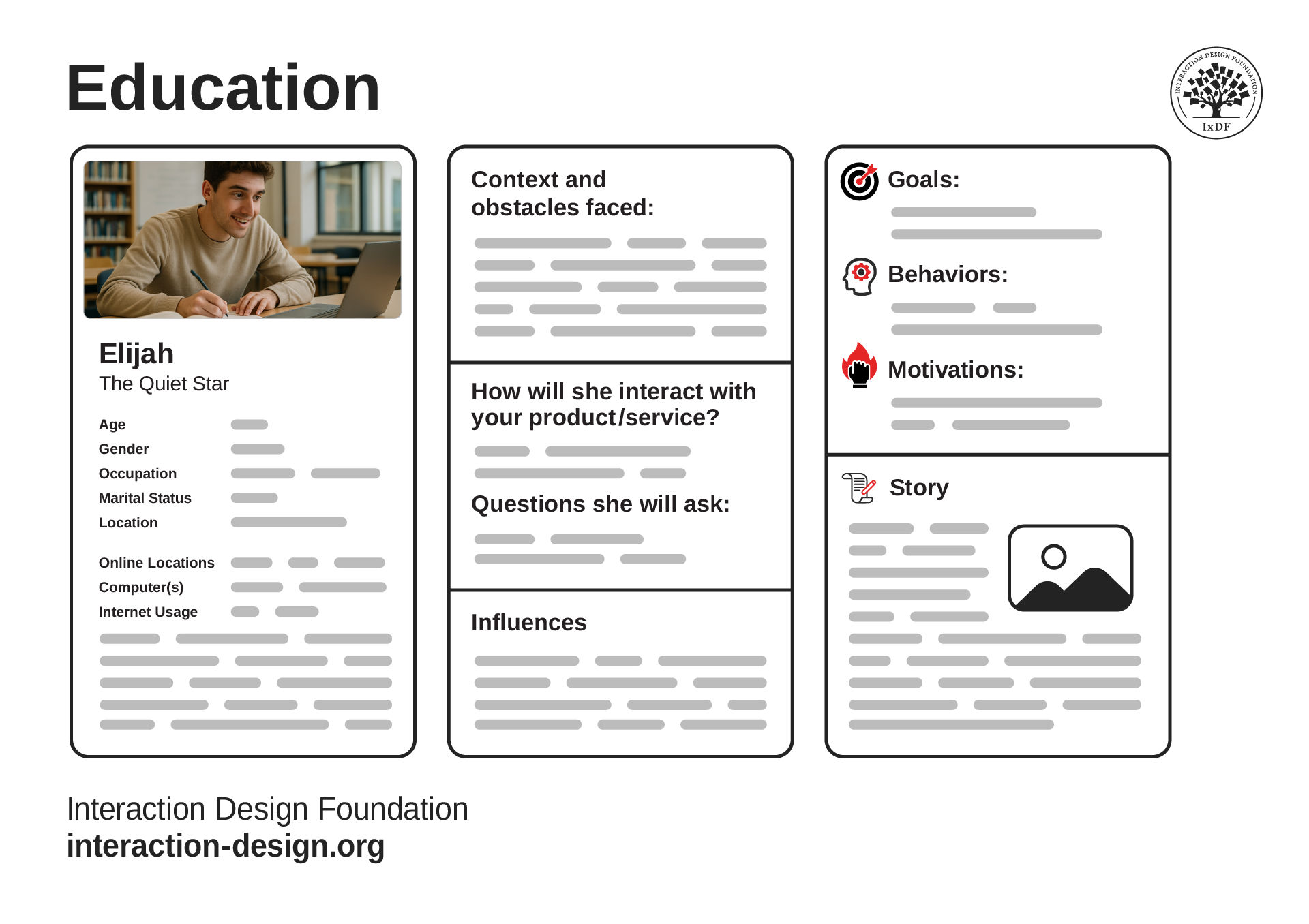
© Interaction Design Foundation, CC BY-SA 4.0
You’re building a learning app—but what if your “average user” can’t express what they need?
Without Personas:
You assume students are motivated by grades, can focus equally well, and prefer text-based learning. Students like Elijah—brilliant, visual learners with reading challenges—get left behind. Teachers think he’s distracted. Elijah thinks he is inadequate and not smart enough.
With Personas:
Elijah’s persona helps you see beyond assumptions and you rewrite the rules. You design with empathy for multiple learning styles, blending video, gamification, and tactile experiences. Now, Elijah gets to shine in his own way.
The Payoff: Learning for Every Mind
When you design for Elijah, you create tools that celebrate different learning styles—not just cater to the average. You become an advocate for inclusive education and help overlooked students thrive and giving educators solutions that finally work for all learners.
HR and Training: Priya, the First-Week Floater
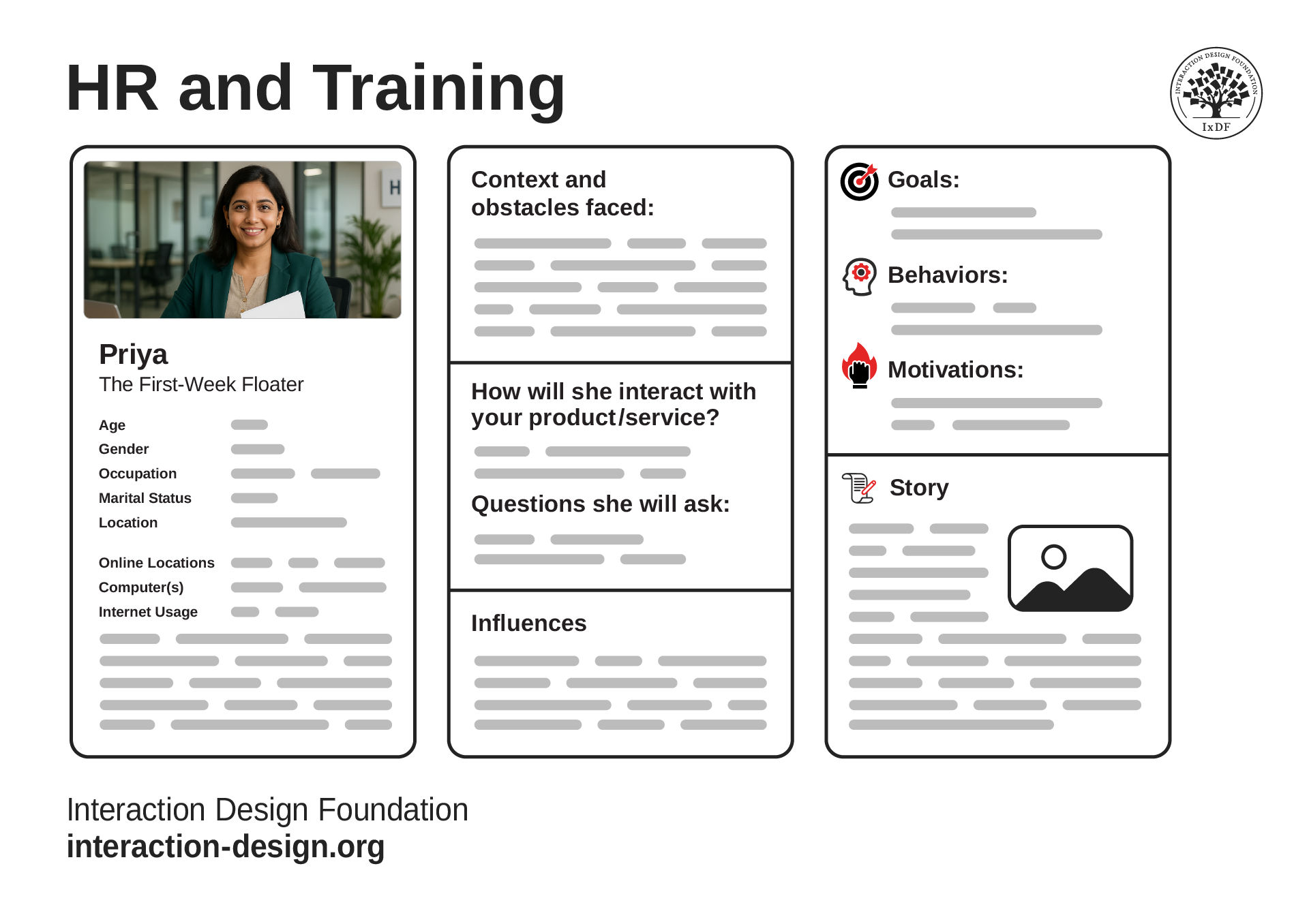
© Interaction Design Foundation, CC BY-SA 4.0
Think back to your first week in a new job. Would you want to be thrown into the deep end with no map?
Without Personas:
Onboarding is one-size-fits-all. Everyone gets dumped into Slack, a drive full of docs, and an LMS that’s more maze than guide. Priya feels invisible, anxious, and unsure if she made the right choice.
With Personas:
Priya’s persona reminds you that onboarding is a human journey. You build a flow that welcomes, reassures, and empowers—complete with bite-sized learning, real mentors, and cultural context.
The Payoff: Onboarding That Builds Belonging
Personas like Priya remind you that onboarding is more than process—it’s a first impression that shapes loyalty, engagement, and culture. You build experiences that make people feel welcomed, seen, and excited to contribute—this turns confusion into clarity from day one.
Retail and Customer Service: Marco, the Grocery Juggler
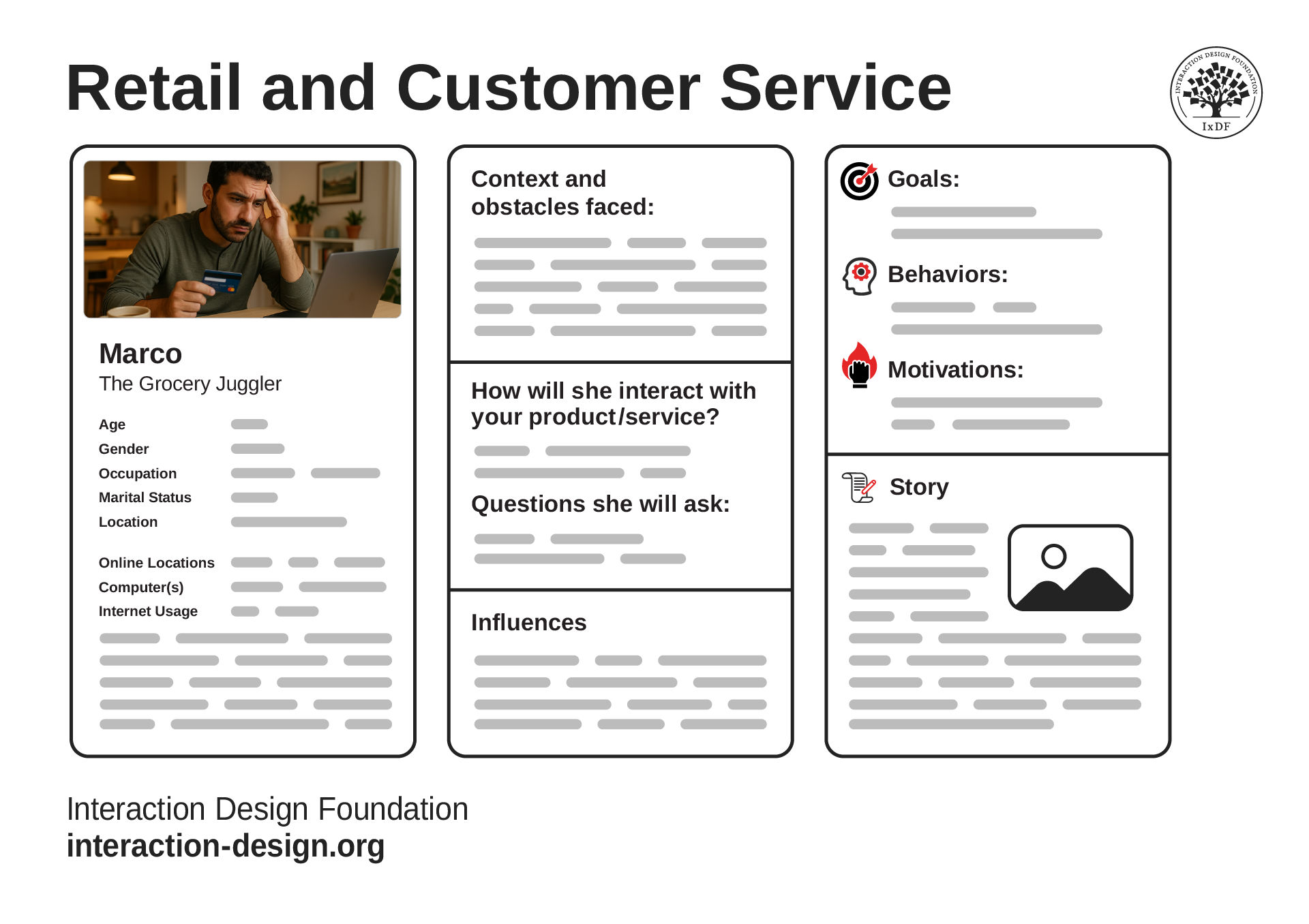
© Interaction Design Foundation, CC BY-SA 4.0
It’s easy to design a checkout flow. But have you tried shopping online while juggling two jobs and a child with allergies?
Without Personas:
You design for “user efficiency.” But allergy filters reset, saved lists disappear, and delivery options don’t fit real-life schedules. Marco’s frustration builds until he gives up—and takes his loyalty elsewhere.
With Personas:
Marco’s persona puts empathy into motion. You prioritize time-saving features, persistent preferences, and personalized reminders. He shops with confidence, safety, and speed.
The Payoff: Turn Friction into Loyalty
When you design for Marco, you understand that convenience isn't a luxury—it’s survival. You fix the pain points that drive customers away, build smarter systems that anticipate real needs, and earn the kind of loyalty that no promo code ever could.
The Big Picture: Why It Matters Everywhere
Without personas, you're flying blind. You build on assumptions and risk missing what really matters.
With personas, you build with intention. You make people feel seen, heard, and supported.
These are just a few industry examples—healthcare, education, HR, retail—but the truth is, if your work involves people, personas can help you. Why? Because personas transform abstract groups into specific, relatable individuals. Whether you design services, plan communication, build software, manage teams, or sell products, you're ultimately trying to influence or support human behavior. Personas give you a clear, research-backed way to understand what real people need, what frustrates them, and what motivates them. They help you focus, empathize, and make decisions with purpose. So even if you're not in design or UX, if your success depends on connecting with others, personas are one of the most powerful tools you can use.
7. Keep It Real: The Importance of Credibility and Simplicity
The best personas aren’t flashy posters filled with trivia. They’re practical tools that teams actually use. That’s why Minimal Viable Personas (MVPs) are so effective. They contain just enough information to guide design decisions:
A name, age, and photo.
A backstory relevant to the domain.
Primary goals and motivations.
Key behaviors and pain points.
In this video, William Hudson talks about Minimal Viable Personas.
Show
Hide
video transcript
- Transcript loading…
Credibility is crucial. If a persona feels fake or exaggerated, your team won’t trust it. Keep it grounded in real research data, make it relatable, and avoid stereotypes or extremes. A good persona should feel like someone you could actually meet.
A simple, credible persona is like a well-designed cognitive shortcut—your brain stores it as a ‘type’ and retrieves it when making decisions. That’s the power of schema theory at work.
The Take Away
Personas are more than a UX design trick. They’re a psychology-based, empathy-fueled way to make decisions that actually work for people. No matter your industry or role, if you work with or for other humans, personas can help you do it better.
When personas are done right, the results speak for themselves:
You build products and services that actually make sense to real people.
Your adoption rates? Up. Satisfaction scores? Higher than your morning coffee.
Your team stops guessing and starts focusing on what really matters.
Even your internal tools and workflows start working with you, not against you.
You save time, energy, and budget by cutting out the guesswork.
You advance your career.
These results aren’t random—they’re rooted in the psychology of how humans empathize, learn, and remember. Personas are designed for how we’re wired. And they’re not just for outward-facing experiences. Personas can improve internal tools, workflows, and even company culture.
So ask yourself: Who am I really working for? If you can answer that with clarity and confidence, you’re already on the path to better outcomes—and happier users.
References and Where to Learn More
Want to know more about personas and how to use them effectively? Personas and User Research: Design Products and Services People Need and Want will show you how to gather meaningful user insights, avoid bias, and build research-backed personas that help you design intuitive, relevant products. You’ll walk away with practical skills and a certificate that demonstrates your expertise in user research and persona creation.
Watch Lead Product Designer at T. Rowe Price, Rafael Hernandez, Master Class Storytelling That Sells UX Design: Define Requirements and Engage Leadership.
Read These Things Called Empathy: Eight Related but Distinct Phenomena by C. Daniel Batson in The Social Neuroscience of Empathy to explore the different forms of empathy, especially how cognitive empathy helps teams understand user perspectives through personas.
Read How Personas Shape Stronger Design Decisions to understand how to use personas to emphasize more effectively.

